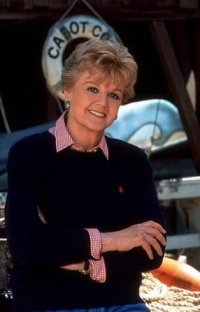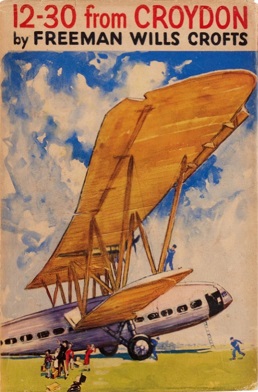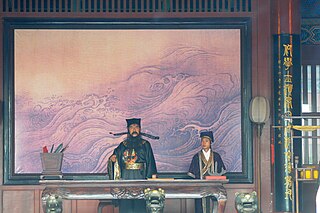Related Research Articles

Detective fiction is a subgenre of crime fiction and mystery fiction in which an investigator or a detective—whether professional, amateur or retired—investigates a crime, often murder. The detective genre began around the same time as speculative fiction and other genre fiction in the mid-nineteenth century and has remained extremely popular, particularly in novels. Some of the most famous heroes of detective fiction include C. Auguste Dupin, Sherlock Holmes, and Hercule Poirot. Juvenile stories featuring The Hardy Boys, Nancy Drew, and The Boxcar Children have also remained in print for several decades.

A whodunit is a complex plot-driven variety of detective fiction in which the puzzle regarding who committed the crime is the main focus. The reader or viewer is provided with the clues to the case, from which the identity of the perpetrator may be deduced before the story provides the revelation itself at its climax. The investigation is usually conducted by an eccentric, amateur, or semi-professional detective.

Crime fiction, detective story, murder mystery, mystery novel, and police novel are terms used to describe narratives that centre on criminal acts and especially on the investigation, either by an amateur or a professional detective, of a crime, often a murder. It is usually distinguished from mainstream fiction and other genres such as historical fiction or science fiction, but the boundaries are indistinct. Crime fiction has several subgenres, including detective fiction, courtroom drama, hard-boiled fiction, and legal thrillers. Most crime drama focuses on crime investigation and does not feature the courtroom. Suspense and mystery are key elements that are nearly ubiquitous to the genre.

Mystery is a fiction genre where the nature of an event, usually a murder or other crime, remains mysterious until the end of the story. Often within a closed circle of suspects, each suspect is usually provided with a credible motive and a reasonable opportunity for committing the crime. The central character is often a detective, who eventually solves the mystery by logical deduction from facts presented to the reader. Some mystery books are non-fiction. Mystery fiction can be detective stories in which the emphasis is on the puzzle or suspense element and its logical solution such as a whodunit. Mystery fiction can be contrasted with hardboiled detective stories, which focus on action and gritty realism.

The A.B.C. Murders is a work of detective fiction by British writer Agatha Christie, featuring her characters Hercule Poirot, Arthur Hastings and Chief Inspector Japp, as they contend with a series of killings by a mysterious murderer known only as "A.B.C.". The book was first published in the UK by the Collins Crime Club on 6 January 1936, sold for seven shillings and sixpence (7/6) while a US edition, published by Dodd, Mead and Company on 14 February of the same year, was priced $2.00.

Columbo is an American crime drama television series starring Peter Falk as Lieutenant Columbo, a homicide detective with the Los Angeles Police Department. After two pilot episodes in 1968 and 1971, the show originally aired on NBC from 1971 to 1978 as one of the rotating programs of The NBC Mystery Movie. Columbo then aired less frequently on ABC from 1989 to 2003.

Crime fiction is a typically 19th-, 20th- and 21st-century genre, dominated by British and American writers. This article explores its historical development as a genre.
The police procedural, police show, or police crime drama is a subgenre of procedural drama and detective fiction that emphasizes the investigative procedure of police officers, police detectives, or law enforcement agencies as the protagonists, as contrasted with other genres that focus on non-police investigators such as private investigators.

Jessica Beatrice "J. B." Fletcher is a fictional detective and writer and the main character and protagonist of the American television series Murder, She Wrote. Portrayed by award-winning actress Angela Lansbury, Fletcher is a best-selling author of mystery novels, an English teacher, amateur detective, criminology professor, and congresswoman. In 2004, Fletcher was listed in Bravo's "100 Greatest TV Characters". AOL named her one of the "100 Most Memorable Female TV Characters". The same website listed her among "TV's Smartest Detectives". She was ranked at number six on Sleuth Channel's poll of "America's Top Sleuths". Guinness World Records called her the "most prolific amateur sleuth".

The 12.30 from Croydon is a detective novel by Freeman Wills Crofts first published in 1934. It is about a murder which is committed during a flight over the English Channel. The identity of the killer is revealed quite early in the book, and the reader can watch the preparations for the crime and how the murderer tries to cover up his tracks. The final chapters of the novel are set in a courtroom and during a private function at a hotel, where a résumé of the whole case is given in front of a small group of police detectives, solicitors, and barristers.
Forensic Files, originally known as Medical Detectives, is an American documentary television program that reveals how forensic science is used to solve violent crimes, mysterious accidents, and outbreaks of illness. The show was originally broadcast on TLC. It is narrated by Peter Thomas, produced by Medstar Television, and distributed by FilmRise, in association with truTV Original Productions. It broadcast 406 episodes from its debut on TLC in 1996 until its final episode in 2011. Reruns shown on HLN were initially retitled Mystery Detectives before settling on the main title of the show in 2014.
Roderick Alleyn is a fictional character who first appeared in 1934. He is the policeman hero of the 32 detective novels of Ngaio Marsh. Marsh and her gentleman detective belong firmly in the Golden Age of Detective Fiction, although the last Alleyn novel, Light Thickens, was published in 1982.

The Pledge is a crime novella by Swiss author Friedrich Dürrenmatt, published in 1958, after Dürrenmatt thought that his previous movie script, Es geschah am hellichten Tag did not have a realistic ending. The film's star, the popular actor Heinz Rühmann, had insisted that Dürrenmatt collaborate with the screenwriter Hans Jacoby, and the story had an ending in line with that of a typical detective story. Dürrenmatt, however, was a critic of that genre of literature, and thus he set out to write Das Versprechen as an expression of that criticism. Although it has been absent from some subsequent editions of the novella, the title of the original edition included the telling subtitle Requiem for the Detective Novel.
Strangers on a Train (1950) is a psychological thriller novel by Patricia Highsmith about two men whose lives become entangled after one of them proposes they "trade" murders.

A Man Lay Dead is a detective novel by Ngaio Marsh; it is the first novel to feature Roderick Alleyn, and was first published in 1934. The plot concerns a murder committed during a detective game of murder at a weekend party in a country house.
Over My Dead Body is a comedy/thriller play, written by Michael Sutton and Anthony Fingleton, "suggested by" Robert L. Fish's 1968 novel The Murder League.
Sleuth 101 was an Australian comedy "improvisatory whodunit game show" television series, broadcast on ABC1 in 2010. The series revolves around a murder-mystery that must be solved by a celebrity guest detective. Each episode features a guest detective, four suspects, a crime scene, evidence and witness accounts - just like real detective work. The show is hosted by comedian Cal Wilson, who occasionally gives subtle hints towards the crime. Each week, the guest detective must solve the murder using his or her evidence. There are some similarities to the 1970s British series Whodunnit!, the 1990s Australian television game show Cluedo, and the 2010s British series Armchair Detectives. A second series was originally being negotiated by the ABC, but later cancelled.

Gong'an or crime-case fiction is a subgenre of Chinese crime fiction involving government magistrates who solve criminal cases. Gong'an fiction first appeared in the colloquial stories of Song dynasty. Gong'an fiction was then developed and become one of the most popular fiction styles in Ming and Qing dynasties. The Judge Dee and Judge Bao stories are the best known examples of the genre.
I, Detective is an American documentary-style series that aired on Court TV from 2001 to 2006.

Armchair Detectives is a British gameshow whodunnit series that debuted in 2017. The show was commissioned for BBC One Daytime and is produced by Tiger Aspect Productions. Hosted by Susan Calman, the series is produced by Carly Brooks and Daniel Twist executive produced by Andy Brereton. The show follows in the footsteps of other similar shows, including Whodunnit? (1972–78), Cluedo (1990–93) and Sleuth 101 (2010). In November 2018, the series won a BAFTA Scotland award for Best Entertainment series.
References
- 1 2 3 4 Orlebar, Jeremy (2013). The Television Handbook. Routledge. p. 216. ISBN 9781136655555 . Retrieved 30 December 2015.
- ↑ Seigneuret, Jean-Charles (1988). Dictionary of Literary Themes and Motifs . Greenwood Publishing Group. p. 381. ISBN 9780313263965 . Retrieved 30 December 2015.
- ↑ Kemp, Sandra; Mitchell, Charlotte; Trotter, David (1997). "Freeman Richard Austin (1862-1943)". Edwardian Fiction: An Oxford Companion. Oxford: Oxford University Press. p. 142. ISBN 978-0-19-811760-5 . Retrieved 2020-06-26.
- ↑ This is a quote from an essay by Freeman entitled "The Art of the Detective Story Archived 2007-07-07 at the Wayback Machine ", which appeared e.g. in Dr. Thorndyke's Crime File (1941).
- ↑ Shead, Jackie (2015). Margaret Atwood: Crime Fiction Writer: The Reworking of a Popular Genre. Ashgate Publishing. p. 7. ISBN 9781472450630.
- ↑ Queen, Ellery (1951). Queen's Quorum: A History of the Detective-crime Short Story as Revealed in the 106 Most Important Books Published in this Field Since 1845. Biblo & Tannen Publishers. pp. 62–63. ISBN 9780819602299.
- ↑ MacDonald, Philip (1963). Three for Midnight. Crime Club.
Murder Gone Mad as a tale of mass-murder, half Whodunit and half (to use a label of my own coining) Howcatchem.
- ↑ Jones, Paul Anthony (2021-05-18). "Howcatchem". Haggard Hawks. Retrieved 2022-10-07.
- ↑ Yusof, Syafiq [@syafiqyusof] (March 23, 2024). "Filem ini tidak menggunakan konsep "Whodunnit" yg selalu kita tonton dalam filem genre misteri. Filem ini berkonsepkan "Reverse Whodunnit" atau lebih dikenali sebagai "Howcatchem" Penonton sudah tahu siapa pembunuh, tapi bagaimana dia akan ditangkap?" (Tweet) (in Malay). Retrieved 2024-04-28– via Twitter.